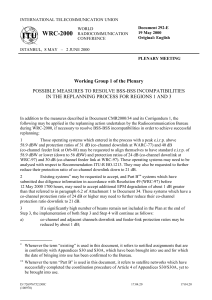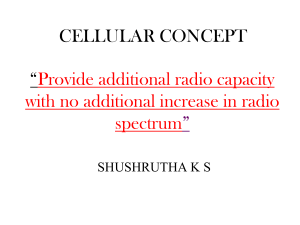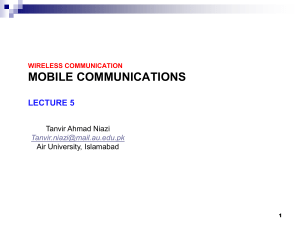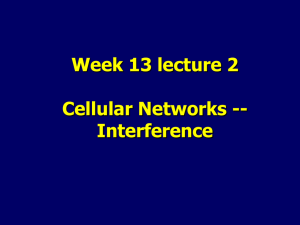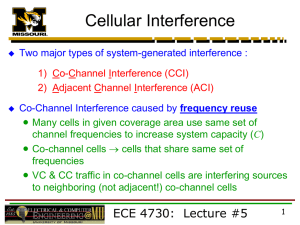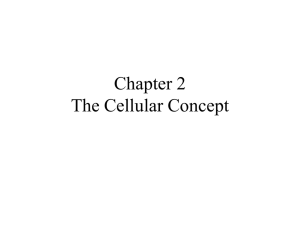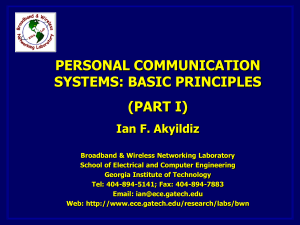Unit 4 co channel interference
advertisement
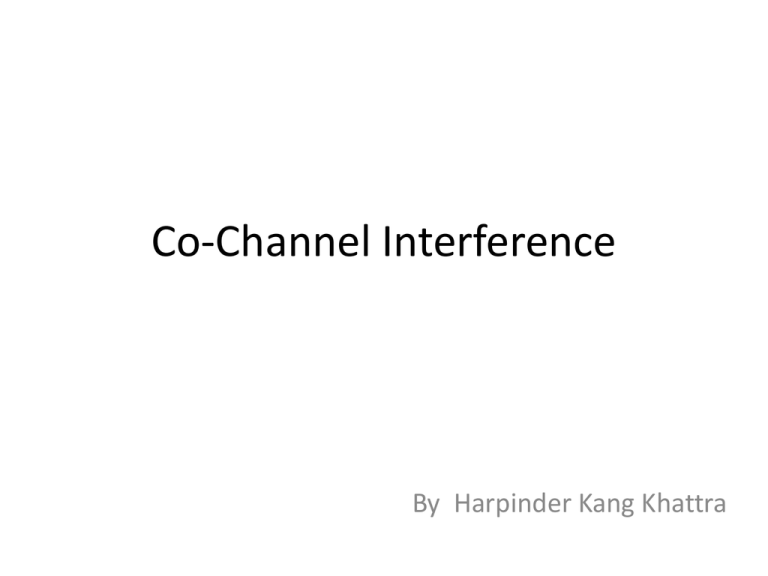
Co-Channel Interference By Harpinder Kang Khattra Topics • Introduction • Real time co channel interference • Co-channel measurement design of antenna system • Antenna parameters and their effects • Diversity receiver in co channel interference – different types Co-Channel Interference • Frequency reuse - there are several cells that use the same set of frequencies – co-channel cells – co-channel interference • To reduce co-channel interference, co-channel cell must be separated by a minimum distance. • When the size of the cell is approximately the same – co-channel interference is independent of the transmitted power – co-channel interference is a function of • R: Radius of the cell • D: distance to the center of the nearest co-channel cell • Increasing the ratio Q=D/R, the interference is reduced. • Q (co-channel interference reduction method) is called the co-channel reuse ratio Co-channel Interference Reduction Factor • Q= D/R • D = f(KI, C/I) • where KI is the number of co channel interfering cells in the first tier and • C/I is the received carrier‐to‐interference ratio at the desired mobile receiver Real time Co-Channel Interference • Signal is • Interference is • The received signal is • Where • And • The average processes on X and Y are • The signal‐to‐interference ratio • The sampling delay time should be small enough to satisfy • Determining the delay time to meet the requirement of above equation for this calculation is difficult and is a drawback to this measurement technique. • Therefore, real‐time co-channel interference measurement is difficult to achieve in practice. Co-channel measurement design of antenna system Design of an Omni-directional Antenna System in the Worst Case • The worst case is at the location where the mobile unit would receive the weakest signal from its own cell site but strong interferences from all interfering cell sites. • To prove that a K = 7 cell pattern does not provide a sufficient frequency‐reuse distance Co-channel interference (a worst case) where q = 4.6, C/I = 17 dB, which is lower than 18 dB. If we use the shortest distance D − R, then Therefore, in an omni-directional-cell system, K = 9 or K = 12 would be a correct choice. Then the values of q are Design of a Directional Antenna System • • • • Call traffic begins to increase Use the frequency spectrum efficiently Avoid increasing the number of cells When K increases, the number of frequency channels assigned in a cell must become smaller • The efficiency of applying the frequency‐reuse scheme decreases • Instead of increasing k ,we use directional antennas to reduce co channel interference Three sector case Let q = 4.6; then Six sector case For q = 4.6, the equation becomes Diversity Receiver In Co-Channel Interference –Different Types • Diversity: It is the technique used to compensate for fading channel impairments. It is implemented by using two or more receiving antennas. • Diversity is usually employed to reduce the depth and duration of the fades experienced by a receiver in a flat fading channel. • These techniques can be employed at both base station and mobile receivers. • Diversity requires no training overhead as a transmitter doesn’t require one. • It provides significant link improvement with little added cost. • It exploits random nature of wave propagation by finding independent ( uncorrelated) signal paths for communication • It is a very simple concept where in one path undergoes a deep fade and another independent path may have a strong signal. • As there is more than one path to select from, both the instantaneous and average SNRs at the receiver may be improved, often as much as 20-30 dB • A diversity scheme is a method that is used to develop information from several signals transmitted over independent fading paths. • It exploits the random nature of radio propagation by finding independent (uncorrelated) signal paths for communication. Objective of Diversity: Combining the multiple signals in such a fashion so as to reduce the effects of excessive deep fades. D ive rsity M a cro sco pic d ive rsity M icro sco p ic d ive rsity Types Of Diversity MACROSCOPIC DIVERSITY MICROSCOPIC DIVERSITY • Prevents Large Scale fading. • Prevents Small Scale fading. • Large Scale fading is caused by shadowing due to variation in both the terrain profile and the nature of the surroundings. • Small Scale fading is caused by multiple reflections from the surroundings. It is characterized by deep and rapid amplitude fluctuations which occur as the mobile moves over distances of a few wavelength. • This fading is prevented by selecting an antenna which is not shadowed when others are, this allows increase in the signalto-noise ratio. • This fading is prevented by selecting an antenna which gives a strong signal that mitigates this small signal fading effect. Div ersity Polo riz ation Div ersity Sele ctio n Div ersity Space Div ersity Scannin g Div ersity Frequency Div ersity Tim e Div ersity Maxim al Ratio Combin ing Equal Gain Combin ing Polarization Diversity Principle : Polarization diversity relies on the decorrelation of the two receive ports to achieve diversity gain. The two receiver ports must remain crosspolarized. Space Diversity Principle : A method of transmission or reception, or both, in which the effects of fading are minimized by the simultaneous use of two or more physically separated antennas, ideally separated by one half or more wavelengths. Space Diversity Selection Diversity Scanning Diversity Maximal Ratio Combining Equal Gain Combining Signals received from spatially separated antennas on the mobile would have essentially uncorrelated envelopes for antenna separations of one half wavelength or more. Selection Diversity Principle : Selecting the best signal among all the signals received from different braches at the receiving end. •Selection diversity offers an average improvement in the link margin without requiring additional transmitter power or sophisticated receiver circuitry. •Selection diversity is easy to implement because all that is needed is a side monitoring station and an antenna switch at the receiver. •However it is not an optimal diversity technique because it does not use all of the possible branches simultaneously. •In practice the SNR is measured as (S+N)/N, since it is difficult to measure SNR. Feedback or Scanning Diversity Principle : Scanning all the signals in a fixed sequence until the one with SNR more than a predetermined threshold is identified. This method is very simple to implement, requiring only one receiver. The resulting fading statistics are somewhat inferior to those obtained by the other methods. Maximal Ratio Combining Principle : Combining all the signals in a cophased and weighted manner so as to have the highest achievable SNR at the receiver at all times. Equal Gain Combining Principle : Combining all the signals in a co-phased manner with unity weights for all signal levels so as to have the highest achievable SNR at the receiver at all times. Frequency Diversity Principle : The same information signal is transmitted and received simultaneously on two or more independent fading carrier frequencies. • The rational behind this technique is that frequencies separated by more than the coherence bandwidth of the channel will not experience the same fade. • The probability of simultaneous fade will be the product of the individual fading probabilities. • This is often employed in microwave LOS links which carry several channels in a frequency division multiplex mode(FDM). Time Diversity Principle : The signals representing the same information are sent over the same channel at different times. • Time Diversity repeatedly transmits information at time spacing that exceeds the coherence time of the channel. • Multiple repetitions of the signal will be received with multiple fading conditions, thereby providing for diversity. • A modern implementation of time diversity involves the use of RAKE receiver for spread spectrum CDMA, where multipath channel provides redundancy in the transmitted message.
